Harryhausen’s Mysterious Island on Blu-ray
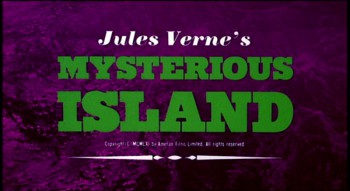 Mysterious Island (1961)
Mysterious Island (1961)
Directed by Cy Enfield. Starring Michael Craig, Herbert Lom, Joan Greenwood, Michael Callan, Gary Merrill, Percy Herbert, Dan Jackson, Beth Rogan.
I have no qualms admitting that I enjoyed the 2007 Walden Media adaptation of Journey to the Center of the Earth. It surprised me how much of Verne’s novel made it onto the screen in a contemporary setting. However, the prospect of a sequel, riffing slightly (at least from what I can detect from the first trailer) on Verne’s 1874 classic The Mysterious Island, does nothing for me other than as a reminder to read that recent translation of the novel from the Modern Library that has stared at me from my “to read” stack for over a year. The new film is called Journey 2: Mysterious Island, which explains exactly what the filmmakers intend: the same thing as the last film. Maybe some younger viewers will go find the book after watching the movie, although the novel is less child-appealing than some of Verne’s other works, such as Twenty Thousand Leagues under the Sea, which children should read first anyway because Mysterious Island is a sequel to it. Will Captain Nemo show up in the new film? Who cares.
However, the marketing for Journey 2 coincides with the Blu-ray release of an earlier adaptation, the Ray Harryhausen-Charles H. Schneer Mysterious Island released in 1961. A number of Harryhausen’s classics have reached Blu-ray already, but Mysterious Island makes its high definition debut in a limited edition from a small direct distributor, Twilight Time, that specializes in film soundtrack albums. This concerns me for the release of other of Harryhausen titles. Mysterious Island is a Columbia film, and Sony Home Video released The 7th Voyage of Sinbad and Jason and the Argonauts on Blu-ray. Apparently, they preferred to farm out Mysterious Island to an independent—and on the film’s fiftieth anniversary! I may never have learned about the Mysterious Island Blu-ray if I wasn’t a soundtrack collector on mailing lists for small labels. (If you want to buy the Mysterious Island Blu-ray, go here. It’s limited to 3,000 unit, and I have no idea how fast they will sell.)
Mysterious Island is the third of Ray Harryhausen’s and producer Charles H. Schneer’s color films. It followed the global success of The 7th Voyage of Sinbad and the tepid The 3 Worlds of Gulliver. Like Gulliver, it goes to the well of classic public domain literature, but Verne is better suited for Harryhausen’s animated antics than Swiftian satire is.
Jules Verne was hot property in the late ‘50s because of Disney’s spectacular smash with 20,000 Leagues under the Sea and Michael Todd’s enormous 70 mm roadshow of Around the World in Eighty Days, which featured every actor alive at the time. A 1959 version of Journey to the Center of the Earth scored a big (despite terrible-looking lizards with fins glued to their backs — always the worst way to create dinosaurs). For Harryhausen and Schneer, picking up Mysterious Island was a no-brainer.
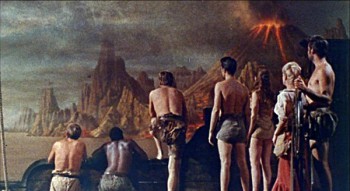 Columbia originally commissioned Crane Wilbur to write a script in 1957. After calculating the cost, the studio found it too expense to produce, and gave it over to Schneer and Harryhausen at Morningside Productions to see if they might bring it in on a tighter budget. Since the original novel isn’t the best source for Harryhausen’s stop-motion animation style—it’s principally a survival story with a few science-fiction elements reserved for the finale—the script needed work to fit with Dynamation, Harryhausen’s patented stop-motion technique. Schneer hired Kenneth Kolb, who wrote the screenplay for The 7th Voyage of Sinbad, to work on the script to include more fantasy elements, but Kolb’s ideas never gelled—except the decision to get rid of the dog sidekick. Good call.
Columbia originally commissioned Crane Wilbur to write a script in 1957. After calculating the cost, the studio found it too expense to produce, and gave it over to Schneer and Harryhausen at Morningside Productions to see if they might bring it in on a tighter budget. Since the original novel isn’t the best source for Harryhausen’s stop-motion animation style—it’s principally a survival story with a few science-fiction elements reserved for the finale—the script needed work to fit with Dynamation, Harryhausen’s patented stop-motion technique. Schneer hired Kenneth Kolb, who wrote the screenplay for The 7th Voyage of Sinbad, to work on the script to include more fantasy elements, but Kolb’s ideas never gelled—except the decision to get rid of the dog sidekick. Good call.
Eventually John Prebble, Daniel Ullman, and Raphael Hayes re-wrote the script to Schneer and Harryhausen’s satisfaction. Final screenplay credit goes to Wilbur, Ullman, and Prebble. I don’t known whom Hayes ticked off.
The re-tooled story adds giant animals to the titular island for the stop-motion marvels: an enlarged crab, a prehistoric bird, enormous bees, and a monster cephalopod. Other effects sequences dropped in and out during pre-production, such as a man-eating plant and Captain Nemo operating a robot-digging machine.
Mysterious Island falls in the middle of the Harryhausen canon as far as quality and excitement. There isn’t enough stop-motion action, and none of the sequences approach classic status. But the direction and pacing keep the story alive; it’s one of the better-constructed screenplays of the Harryhausen films, and doesn’t rely on a standard “quest” narrative, but instead focuses on characters working together in a single location to overcome threats. It’s a good piece of adventure storytelling, but not the imaginative thrill-ride of the first two Sinbad movies or Jason and Argonauts. The film seems better when approached as a general adventure film, rather than as a “Harryhausen” film.
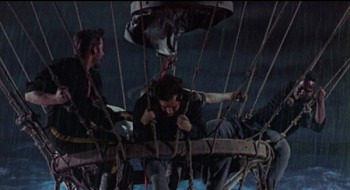 The plot follows the outline of the novel, with a group of Union captives escaping from a Confederate prison in Richmond with the help of an observation balloon. Leading the captives is Captain Cyrus Harding (Michael Craig). He’s accompanied by Herbert Brown (Michael Callan); Neb Nugent (Dan Jackson), described in the novel as an ex-slave and Harding’s “manservant”; and Philadelphia war correspondent Gideon Spillit (Gary Merrill). They pick up an accidental passenger, Confederate balloonist Sgt. Pencroft (Percy Herbert), who is the only man who can handle the balloon as it flies off into “the greatest storm in history.”
The plot follows the outline of the novel, with a group of Union captives escaping from a Confederate prison in Richmond with the help of an observation balloon. Leading the captives is Captain Cyrus Harding (Michael Craig). He’s accompanied by Herbert Brown (Michael Callan); Neb Nugent (Dan Jackson), described in the novel as an ex-slave and Harding’s “manservant”; and Philadelphia war correspondent Gideon Spillit (Gary Merrill). They pick up an accidental passenger, Confederate balloonist Sgt. Pencroft (Percy Herbert), who is the only man who can handle the balloon as it flies off into “the greatest storm in history.”
The balloon eventually drops its passengers at an island in the Pacific. Yes, that was a big storm. The men band together to survive in the tropical wilderness. They encounter enlarged beasts and plants, help two more castaways, Lady Mary Fairchild (Joan Greenwood) and Herbert’s love interest, Elena Fairchild (Beth Rogan), and discover that an unseen benefactor is aiding them in their survival.
The identity of the mystery helper might be considered a spoiler — except the beginning credits proclaim in big letters: “And HERBERT LOM as CAPTAIN NEMO.” So there you go: the mystery helper is Captain Nemo. He docked a damaged Nautilis in caverns beneath the island, and has done experiments on the local flora and fauna to enhance them as part of a plan to increase the world’s food supply. Unfortunate side-effect: attacks by killer crabs and bees and big bird thingies. But Nemo wasn’t expecting company.
Except for a bit of grousing about who will lead the balloon-wrecked crew and young Herbert wondering if he has fortitude, little conflict occurs between the castaways. The film’s conflict is external: survive. The harmony between the characters highlights that people can endure harsh conditions through teamwork, cooperation, and ingenuity — the opposite of how a movie today would deal with the same situation. It’s the anti-Survivor. Nemo, one of the great misanthropes in literature, deems these people worthy of his aid because they work together for the common good.
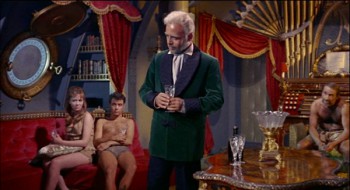
Although thematically intentional, the harmony still comes across as too pat in places. This was the first time watching the movie that I noticed how many places the script passes up opportunities for conflict. The southern Sgt. Pencroft falls in fast with Northerners, and everyone forgets about the Civil War in a hurry. Neb is black, but the script ignores this completely except for subtle indications that the others think he’s inferior. (He also gets nothing important to do in the film, unfortunately a common situation for black supporting actors of the time.) Herbert romances Elena for one scene, and snap! They’re in love without a hint of trouble. As a writer I find this pretty weird, and I can’t help imagining the “missing” scenes. The harmony theme is a positive one, but more adversity at the beginning would make the theme stronger. This means altering Verne’s story, but the movie already added a prehistoric giant chicken-parrot-ostrich whatchamacallit; Verne could handle a few more tweaks.
Considering the lack of character-driven drama, it is impressive that Mysterious Island works as well as it does. The constant dangers, the mystery of who is providing help (even if the credits gave it away to the audience), and the cleverness of the castaways’ plans carry the film along. The story constantly moves, even if the people never face trouble among themselves.
Having a good cast and director helps. Most of the characters have colorful personalities, which prevents the absence of intrapersonal drama from damaging the film too much. Michael Craig is adequate as Captain Harding; the ensemble doesn’t need to lean on one person’s heroics. The standouts among the cast are the vibrant characters of Pencroft (English actor Percy Herbert performing an impeccable thick southern U.S. accent), comic Spillit, and the fussy and overwhelmingly English Lady Fairchild.
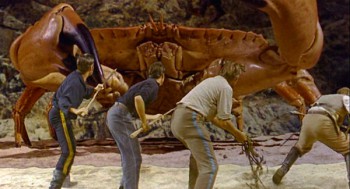
Herbert Lom is the only “name” in the cast, playing Jules Verne’s most famous creation. Lom has the unenviable task of comparison to James Mason’s monumentally great portrayal of Nemo in Disney’s 20,000 Leagues under the Sea, but few other actors at the time seem more right for the part than Lom. He’s commanding, classy, arrogant … Nemo, dead-on. It’s a pleasure to watch him even if he is not James Mason.
Nemo’s other half, the Nautilis, fares far worse. 20,000 Leagues under the Sea cost approximately half a bazillion dollars and would have bankrupted Walt Disney Studios if it flopped. Mysterious Island cost less than a tenth of a bazillion (a decazillion?), and it shows most in the Natuilis interior, which looks like a community theater set compared to the Disney movie. The lush outdoor location photography in Spain makes Mysterious Island feel more expansive than it is, so the Nautilis is an unfortunate reminder of budget realities.
Much of what works with Mysterious Island away from the visual effects can be attributed to director Cy Enfield, a rare case of an acclaimed director working on a Ray Harryhausen film. Born in the U.S. but based in England because of blacklisting, Enfield helmed the classic crime film The Underworld Story, and three years after Mysterious Island directed one of the greatest British war films, Zulu. He’s at home with the adventure and scope of Mysterious Island and gets plenty out of characters who don’t have much conflict between each other.
On to our featured entertainment: Ray Harryhausen’s special effects.
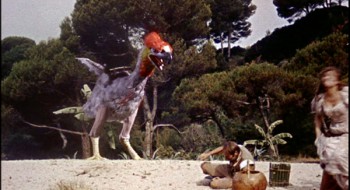 There are four “Dynamation” scenes: a large crab, a prehistoric bird, huge bees, and a giant cephalopod. Harryhausen’s technical work is his usual high quality, but nothing leaps out as classic. There’s no “skeleton duel” or “Medusa” or “Kali” moment, the magic sequence that elevates the entire movie.
There are four “Dynamation” scenes: a large crab, a prehistoric bird, huge bees, and a giant cephalopod. Harryhausen’s technical work is his usual high quality, but nothing leaps out as classic. There’s no “skeleton duel” or “Medusa” or “Kali” moment, the magic sequence that elevates the entire movie.
One reason for this is that, except for the prehistoric bird, all the creatures in the film are based on existing animals and lack the fantasy quality of the dinosaurs and mythological beasts that populate Harryhausen’s work. The crab, for example, is a real crab: Harryhausen constructed it using a crab’s exoskeleton and fitting the armature inside it.
It’s no surprise that the prehistoric bird, referred to in the script as a “phororhacos,” is the best of the Dynamation creatures. It’s a weird-looking thing, silly in design (nooooo! a giant chicken!) but fierce on the attack, resulting in an off-kilter scene in an otherwise serious tale. Harryhausen never intended it to play as humorous, but composer Bernard Herrmann latched onto the inherent absurdity of the bird and gave it a plucky-yet-menacing dance jig for accompaniment. The mix of terror and humor makes for the most memorable scene in the film. The finest bit of Harryhausen’s slight-of-hand occurs here, where he makes a seamless transition from the model of Herbert attacking the phororhacos to the actual actor as the bird collapses. I had to watch it a frame at a time to catch the moment with Harryhausen switches to the actor from the model.
The bees (or bee; only one model was built) have the most detailed design; they look astonishingly real. Unfortunately, they don’t have much to do, and it seems a larger sequence could have been worked around them. The bee sealing up Herbert and Elena with wax is a clever piece of animation, however.
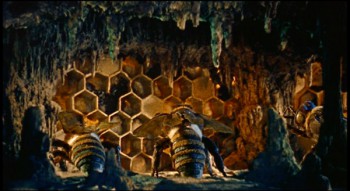 The crab, although uninteresting itself, gets a decent fight that takes up just the right length of time on screen. It never rises to greatness however, because the staid choreography keeps the actors in the same place most of the time. Full-scale prop claws and legs used on location help the actors interact with the monster crustacean, but the fight needs greater movement and energy.
The crab, although uninteresting itself, gets a decent fight that takes up just the right length of time on screen. It never rises to greatness however, because the staid choreography keeps the actors in the same place most of the time. Full-scale prop claws and legs used on location help the actors interact with the monster crustacean, but the fight needs greater movement and energy.
The cephalopod is a creature audiences often forget is even in the movie. Its attack on the underwater team trying to repair a sunken pirate ship is a bore. The model does not move much, and a watery distortion effect obscures it. The humans stuck moving in slow motion are no help at picking up the scene. Thankfully, it only lasts a minute on screen.
Apart from the four Dynamation sequences, Mysterious Island is packed with other visual effects: optical and matte painting work of the island’s volcano and an underwater city; a model of a sinking pirate ship; and a miniature grotto where the crippled Nautilis lies. Harryhausen has expressed dislike for some of the matte paintings, but the scene of the men crossing a fallen tree over a chasm against a backdrop of a jungle waterfall is gorgeous and an obvious homage to the log scene from King Kong.
The film opens and closes two with immense VFX set-pieces. The escape from the Richmond prison in the balloon is perhaps the best effects work Harryhausen did outside of stop-motion, and Enfield’s handling of the drama during the break-out and later crash-landing make this a wild ride and an explosive way to get the film started. The finale has the island’s volcano blowing up while the castaways race to repair and raise a sunken pirate ship to escape. Harryhausen relies on some volcano stock footage, but the model work of the collapse of the island is superlative.
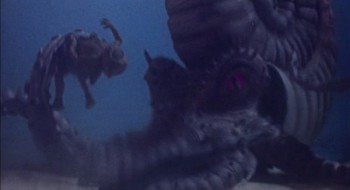 The Blu-ray offers three audio options: the original theatrical mono, a lossless DTS-HD 5.1 mix, and an isolated music track for Bernard Herrmann’s score. This last track is probably the reason Twilight Time picked up the movie in the first place, since Herrmann is unanimously hailed among score collectors as the greatest composer in the medium. I prefer Jerry Goldsmith, but I can’t argue with Herrmann’s overwhelming influence and talent, and his scores for Harryhausen were among the first movie soundtracks I fell in love with.
The Blu-ray offers three audio options: the original theatrical mono, a lossless DTS-HD 5.1 mix, and an isolated music track for Bernard Herrmann’s score. This last track is probably the reason Twilight Time picked up the movie in the first place, since Herrmann is unanimously hailed among score collectors as the greatest composer in the medium. I prefer Jerry Goldsmith, but I can’t argue with Herrmann’s overwhelming influence and talent, and his scores for Harryhausen were among the first movie soundtracks I fell in love with.
The picture quality on the Blu-ray is solid. Keep in mind the source material is a mid-budget film half-a-century old that makes extensive use of optical effects; only the distorting use of heavy DNR could make it as pristine as a 2011 movie, and that wouldn’t look anything like Mysterious Island. The grain is extensive but natural, and the film has never looked this good since it was first on theater screens fifty years ago.
The Hi-Def clarity enhances the effects scenes, even though it would seem the opposite would happen. Flaws in the opticals are noticeable, principally the difference in quality between the elements in shots with matte paintings and mismatches between the stop-motion models and the live-action footage (this is most glaring in the crab fight, where what the sand the crab stands on looks nothing like the beach the humans are on), but this doesn’t diminish the work at all. It actually makes it more interesting to watch and gives the film a human quality you never get with slick CGI.
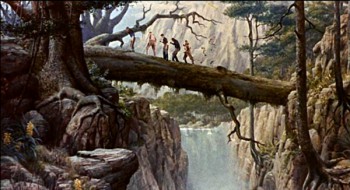 The 5.1 audio is problematic. Re-purposing a mono film, especially one so old, presents difficulties. The mix on Mysterious Island uses distracting surround effects that aren’t organic to the soundscape. The reason the track exists is to showcase the score, which does sound spectacular: crank up the booming “storm theme” over the main credits, then switch over to the more natural monaural track for the best listening experience.
The 5.1 audio is problematic. Re-purposing a mono film, especially one so old, presents difficulties. The mix on Mysterious Island uses distracting surround effects that aren’t organic to the soundscape. The reason the track exists is to showcase the score, which does sound spectacular: crank up the booming “storm theme” over the main credits, then switch over to the more natural monaural track for the best listening experience.
And speaking of the score … AWE-SOME! Herrmann kills it with a brass and percussion sound that just about steamrollers the listener. The clashing “storm theme” that plays over the credits and the escape from the Confederate jail is one of the best main titles the composer wrote for sheer catalyzing power. The crab music is clever, giving the sense of the multiple limbs moving on their own with each instrument acting independently. The phororhacos get a musical joke: Herrmann told Harryhausen before the scoring session that he was going to use “Turkey in the Straw” for the scene. He wasn’t far off.
The “isolated score” track isn’t purely isolated. Sound effects sometimes appear in the quieter cues, although all the dialogue is gone. Twilight Time likely only had access to the actual soundtrack on the film, and not the master tracks from the recording sessions.
The chapter stops aren’t scene-specific, just plunked down every ten minutes. Not surprising for an independent label, but nothing that annoys me too much. That I got the disc at all, and with good picture quality, compensates.
Ryan Harvey is one of the original bloggers for Black Gate, starting in 2008. He received the Writers of the Future Award for his short story “An Acolyte of Black Spires,” and his stories “The Sorrowless Thief” and “Stand at Dubun-Geb” are available in Black Gate online fiction. A further Ahn-Tarqa adventure, “Farewell to Tyrn”, is currently available as an e-book. Ryan lives in Los Angeles. Occasionally, people ask him to talk about Edgar Rice Burroughs or Godzilla in interviews.
Hey Ryan, I have a question that’s been beyond my ability to answer from a decade or so. When I was young, at my grandfather’s house, I saw a movie where a group of people got caught in a tree during a titanic flood. Also trapped in the tree with them was a large predatory cat, like a leopard. Do you have any recollection of what this film might have been?
Oh, and nice article BTW!
Appropriately enough, Scott, you are thinking of another Jules Verne adaptation: Disney’s 1962 live action film In Search of the Castaways. The heroes get caught in a tree during a flash flood, which has also trapped a jaguar. I remember seeing this in the ’70s on Disney’s Sunday evening TV show and loving it. It’s been years since I’ve checked it out. I recall the volcano finale was pretty terrifying when I was a kid.
Awesome Ryan, thanks! I think the Jules Verne angle most certainly pointed me in the right direction. Now to see about finding this movie someplace…
[…] not as good as Jason and the Argonauts or The Golden Voyage of Sinbad, but right on the level of Mysterious Island, although lacking a Bernard Herrmann score. The scene of Perseus fighting the Minotaur in the […]
[…] Balloon Escape and Crash from Mysterious Island […]
how effective is Belly dancing…
Black Gate » Blog Archive » Harryhausenâs Mysterious Island on Blu-ray…
Why was James Mason not casted for the role of Captain Nemo in this movie?